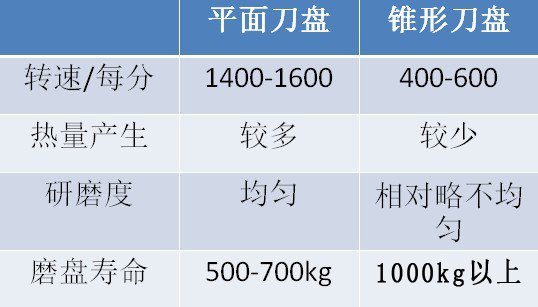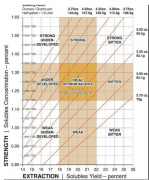Effect of Bean Mill Grinding on Coffee Flavor
Like drinking coffee, is a hobby, like making coffee, is a kind of mood, like making coffee, is a way of life.
In China, more and more people begin to fall in love with coffee and coffee life. Baristas constantly study how to make better coffee. They constantly try the different flavors of coffee beans in different places, the different tastes brought by various brewing utensils, and the personality shown by various brewing techniques, but often ignore the importance of bean grinders to all this.
Among the factors that determine the taste of coffee brewing, "beans", "grinding" and "machine" are hardware factors, and "technology" is software factors. today, Chongqing Brista Coffee West Point training School will discuss in detail the impact of "grinding" on coffee taste.
At present, there are many kinds of bean grinders on the market, but they can be divided into parallel grinding, conical grinding, roller grinding, ghost tooth grinding, machete grinding and so on. Among them, the roller mill is mostly used in large factories to crush beans like a noodle machine, which has high grinding efficiency, but is not suitable for cafes, while machete grinding is mostly a household simple bean grinder, which uses a blade to tell the power of rotation to chop up beans with extremely low uniformity and high calorific value, which is not conducive to the extraction of coffee flavor. Parallel mill and conical mill are the mainstream grinding discs at present, and the differences are as follows:

Generally speaking, the parallel grinding disc has the advantages of fast rotational speed, fast grinding and more uniform grinding, while the disadvantage is easy to heat and relatively short life, while the tapered grinding disc has the advantages of not easy to heat and long life, and the disadvantage is slow and uneven.
At present, the Japanese Fuji ghost tooth grinding plate can grind more uniform coffee powder, at the same time produce less fine powder, and the grinding efficiency is higher. But it is not suitable for the extraction of espresso.
There are four main factors affecting extraction by bean grinder:
Evenness: coarser coffee particles are more likely to be underextracted, while finer particles are overextracted in advance, so the coffee powder with a larger span of grinding thickness can taste more turbid and irritating smells. When the coffee powder with the same size and similar shape is used for extraction, the taste becomes brighter and stronger, and the performance of flavor characteristics is clearer and consistent.
The amount of fine powder: coffee powder close to flour can easily be overextracted or even dissolved in water, thus affecting the extraction taste of coffee. The more fine powder, the more easily coffee is over-extracted, and the more bitter the taste is, the more mixed it is. When making espresso, the fine powder will first be washed out by the water and into the cup. If extracted properly, the thick oil will hold up the fine powder, and the fine powder will float on the surface of the oil, forming a beautiful "tiger spot". But "tiger spot" does not represent the taste of espresso. The production of fine powder can be reduced by choosing a better bean grinder or using a sieve. However, if there is no fine powder at all, the coffee brewed will also lack a sense of hierarchy, and the balance can only be put into practice, not in words.
Calorific value: the grinding plate of any bean grinder will generate heat in the grinding process, and the heating of coffee powder will accelerate the oxidation process and accelerate the volatilization of aroma, resulting in the weakening of coffee flavor after brewing. The calorific value of the cutter head depends on the size of the grinding plate, the material used, the structure of the knife, the fineness of grinding, the speed of the motor, the hardness and texture of coffee beans and many other factors. Therefore, at present, large brands of bean grinders begin to be equipped with heat dissipation windows, cooling fans, choose more heat-dissipating metal, or drive the cutter head with higher torque and low speed motor, so as to reduce heat generation.
Static electricity: generally speaking, the finer the grinding, the faster the grinding machine, the stronger the static electricity generated; the internal material is plastic, and the lower powder mouth does not use the bean grinder designed to reduce static electricity, so the static electricity generated is stronger; the coffee beans with rich oil and deep roasting are ground, the static electricity generated is stronger. When the Italian bean mill is grinding, it often appears that the fine powder agglomerates, which affects the density after the cloth powder, resulting in uneven extraction, while the iron absorber at the outlet of the single bean mill absorbs silver skin and fine powder through static electricity to help reduce the taste and miscellaneous smell of excessive extraction.
Important Notice :
前街咖啡 FrontStreet Coffee has moved to new addredd:
FrontStreet Coffee Address: 315,Donghua East Road,GuangZhou
Tel:020 38364473
- Prev

Research: coffee can improve people's ability to process information
A team led by psychologist Thaddeus T. Bruny of Tufts University (Tufts University) in Massachusetts conducted a comparative experiment on two groups of people to study the effects of different doses of caffeine on people's ability to read and proofread articles. This is part of a large research project on stimulation and cognitive behavior. 36 subjects in the first group
- Next

Little knowledge of extraction rate and concentration of boutique coffee
Coffee should be based on the taste, the extraction rate data can help to correct when there is something wrong with the taste of coffee, the data can be used as a reference, but it is not the absolute criterion of taste. TDS=TotalDissolved Solids is a measuring tool used to measure the total content of dissolved solids in water; concentration and extraction rate are the reference indicators to measure the quality of a cup of coffee. As long as the coffee concentration is 1.
Related
- Beginners will see the "Coffee pull flower" guide!
- What is the difference between ice blog purified milk and ordinary milk coffee?
- Why is the Philippines the largest producer of crops in Liberia?
- For coffee extraction, should the fine powder be retained?
- How does extracted espresso fill pressed powder? How much strength does it take to press the powder?
- How to make jasmine cold extract coffee? Is the jasmine + latte good?
- Will this little toy really make the coffee taste better? How does Lily Drip affect coffee extraction?
- Will the action of slapping the filter cup also affect coffee extraction?
- What's the difference between powder-to-water ratio and powder-to-liquid ratio?
- What is the Ethiopian local species? What does it have to do with Heirloom native species?

